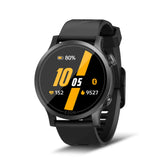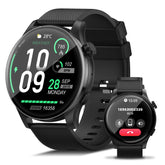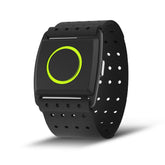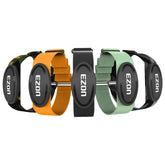Outdoor Adventure 101: Gear, Navigation, and Safety Tips for Hikers
Stepping into the great outdoors is an invitation to explore, challenge yourself, and connect with nature—but preparation is key to a safe and enjoyable hike. This guide breaks down essential hiking gear, navigation tips, and trail safety practices, including how a rugged sports watch can be your ultimate outdoor companion. Whether you’re tackling a local trail or a multi-day trek, gear up with confidence and conquer every terrain.
1. Essential Hiking Gear: Pack Smart, Hike Hard
A. Footwear: The Foundation of Comfort
- Day Hikes (Easy Trails): Lightweight trail runners (e.g., Salomon X Ultra) for breathability and agility on well-maintained paths.
- Multi-Day Treks: Waterproof, high-top boots with Vibram soles (Lowa Renegade) for ankle support and protection on rocky, wet terrain.
- Pro Tip: Break in new shoes with 50+ miles of training hikes to avoid blisters.
B. Clothing: Dress in Layers for All Weather
- Base Layer: Moisture-wicking merino wool or synthetic tops/bottoms (avoid cotton, which retains moisture and chills the body).
- Insulating Layer: Fleece or down jacket for cold weather—packable and lightweight (e.g., Patagonia Nano Puff).
- Outer Layer: Gore-Tex waterproof shell for sudden storms; look for 2.5-layer designs for breathability during intense hikes.
C. Navigation Tools: Never Lose Your Way
- Physical Map & Compass: Waterproof topographic map of the area; learn to use a compass for grid navigation (critical when electronics fail).
-
Rugged Sports Watch:
- Multi-Satellite Navigation: Access GPS, GLONASS, and Galileo for precise positioning in remote areas.
- Preloaded Trails: Download GPX routes from platforms like AllTrails directly to your watch.
- Altimeter/Barometer: Monitor elevation gain and predict weather changes (falling pressure signals incoming storms).
D. Backpack: Carry Essentials Efficiently
- 20–30L for Day Hikes: Padded hip belts to distribute weight (Osprey Daylite); include a hydration bladder (2L) for easy access to water.
- 50–70L for Overnight Trips: Features like external gear loops for trekking poles and a rain cover for wet conditions.
2. Navigation Tips: Master the Art of Trail Finding
A. Traditional Navigation Basics
- Map Reading: Align the map with north using a compass; identify key landmarks (rivers, peaks, trail junctions) to confirm your position.
- Cairns & Blazes: Follow stacked stones (cairns) on unmarked trails or colored paint blazes (e.g., white for Appalachian Trail) at intersections.
B. Leverage Technology Wisely
-
Rugged Watch Features:
- Waypoint Marking: Save critical points (trailheads, water sources, campsites) for easy backtracking.
- Breadcrumb Trail: Activate this feature to record your path and navigate back if you lose the trail.
- Offline Maps: Download trail maps in advance using apps like Gaia GPS—no cell service needed.
C. Stay Oriented in Poor Visibility
- Use Natural Signs: Moss typically grows on the north side of trees in the Northern Hemisphere; follow river 流向 (downstream leads to civilization in many cases).
3. Trail Safety: Prepare for the Unexpected
A. Weather Awareness
- Check Forecasts: Use your rugged sports watch for real-time updates; turn back if thunderstorms are predicted.
- Dress for Temperature: Carry extra layers even on sunny days—temperatures can drop 30°F at higher elevations.
B. Emergency Preparedness
-
10 Essentials (Updated):
- Navigation: Map, compass, watch
- Headlamp: With extra batteries
- Sun Protection: Hat, sunglasses, SPF 50+
- First Aid Kit: Include blister pads, pain relievers, and emergency blanket
- Knife/Multi-Tool: For cutting rope or building shelter
- Fire Starter: Waterproof matches or lighter
- Shelter: Lightweight tent or space blanket for unexpected overnight stays
- Extra Food: 2,000+ calories of non-perishable snacks (nuts, energy bars)
- Water Filter: Sawyer Squeeze for safe hydration from streams
- Layers: As mentioned earlier
C. Wildlife Encounters
- Stay Calm: Keep 50+ feet distance from large animals (deer, elk); make noise on narrow trails to avoid surprising wildlife.
- Food Storage: Use bear-proof canisters in designated areas to prevent attracting animals to campsites.
D. Communication Tools
- GPS Watch with SOS: Models like EZON GPS Series offer emergency beacon features in some regions.
- Whistle: Three short blasts signal distress—carry one attached to your pack.
4. Terrain-Specific Tips for Different Trails
A. Mountain Hikes (Steep Terrain)
- Pacing: Take short, steady steps; use trekking poles to reduce knee pressure (20% less impact on descents).
- Altitude Adjustment: Spend 1–2 days acclimating above 8,000 feet to avoid AMS (Acute Mountain Sickness).
B. Forest/Jungle Trails (Overgrown Terrain)
- Insect Protection: Wear long sleeves treated with permethrin; carry DEET-based repellent for ticks/mosquitoes.
- Foot Care: Check for leeches or debris in shoes at every rest stop.
C. Desert/High Heat Trails
- Hydration: Drink 1L/hour in temperatures above 90°F; add electrolytes to prevent cramps.
- Sun Protection: Wear a wide-brimmed hat and lightweight, UV-protective clothing (UPF 50+).
5. Leave No Trace: Protect the Outdoors for Future Adventures
- Pack Out All Waste: Including food scraps and microtrash (energy gel wrappers).
- Stay on Trails: Veering off-path damages fragile ecosystems—use your rugged sports watch to stay on marked routes.
- Respect Wildlife: Never feed animals; keep pets leashed to avoid disturbing habitats.
6. FAQs: Common Hiking Questions Answered
Q: How do I choose the right rugged sports watch?
- Prioritize battery life (40+ hours for multi-day hikes), water resistance (10ATM+), and offline map support (e.g., EZON GPS Series).
Q: What if I get lost?
- Stop, stay calm, and retrace your steps using your watch’s breadcrumb trail; if unsure, activate SOS and wait for rescue.
Q: How to pace myself on long hikes?
- Use your watch’s GPS to track speed; aim for 2–3 mph on flat terrain, reducing to 1–2 mph on steep ascents.
Gear Up and Explore with Confidence
With the right hiking gear, solid navigation tips, and a focus on trail safety, every hike becomes a rewarding adventure. A rugged sports watch isn’t just a tool—it’s your partner, ensuring you navigate safely, track progress, and respect the environment.
So lace up your boots, strap on your watch, and hit the trail with curiosity and caution. The outdoors awaits—explore it wisely, and let every step be a journey of discovery.
EZON Watch: Professional sports technology brand
https://ezonwatch.com
https://ezonwatch.com









